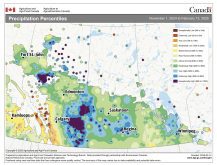The latest inflation and employment reports show the Canadian economy could be cooling too fast, prompting several prominent economists to encourage the Bank of Canada to aggressively cut interest rates.
The bank met this week and was expected to cut its key rate by at least 25 basis points or more. This column was written before the bank made its announcement (see story linked below).
Related story: Bank of Canada cuts rates, hails ‘good news’ on low inflation
Read Also

Huge Black Sea flax crop to provide stiff competition
Russia and Kazakhstan harvested huge flax crops and will be providing stiff competition in China and the EU.
Five of the six big commercial Canadian banks expected a 50 basis point cut this week, and many expect another 50 point cut in December. The bank does not meet in November.
That would bring down the key rate to 3.25 per cent, a level considered to neither dampen nor stimulate economic activity.
Soaring inflation around the world in 2021-22 caused the Bank of Canada, like other central banks, to aggressively increase interest rates.
The Canadian rate peaked in July 2023 at five per cent and stayed there until June this year, when the bank made a 25 basis point drop, followed by equal drops in August and September.
The U.S. central bank, the Federal Reserve, has also cut its rate, as has the European Central Bank and Bank of England.
All of them have successfully lowered the rate of inflation without causing massive unemployment and all are now deciding how fast to cut rates.
Bank of Canada economists watch several economic statistics, including monthly inflation and employment data, to inform its decisions on setting interest rates.
Did it wait too long to start cutting?
Statistics Canada’s inflation measure for September showed prices, not seasonally adjusted, up 1.6 per cent over 12 months.
That is within the bank’s goal of one to three per cent annual inflation. Housing costs, which mean rent and mortgage payments, make up a large part of the inflation calculation, and they are stubbornly high, driven by the housing shortage.
Food was up 2.8 per cent over 12 months.
However, other components of inflation have fallen. Notoriously volatile gasoline was down 10.7 per cent compared to the previous year.
Clothing and footwear were down 4.4 per cent, transportation down 1.5 per cent and recreation, education and reading were flat.
Economist David Rosenberg of Rosenberg Research & Associates Inc. noted that these components of the economy showed signs of disinflation and the danger of recession. As a result, sharp interest rate cuts were warranted.
There is also concerning news on the jobs front.
Canada’s economy has rapidly created jobs since the end of the pandemic but has not kept up with the rapid rise in population, which is driven by immigration.
In the two years from September 2022 to September 2024, employment grew an impressive 4.5 per cent, or 891,000 to 20.647 million, according to Statistics Canada.
However, in roughly the same period, the population grew by six per cent, or 2.35 million to 41.29 million.
The unemployment rate in September was 6.5 per cent, up from a post-pandemic low of 4.8 per cent in July 2022.
The unemployment rate among men between 15 to 24 years old is particularly high, reaching 15.3 per cent in September.
This is another sign that the Bank of Canada needs to take its foot off the brake.
Royal Bank Economics agreed with the expectation of two 50 basis point cuts this year, bringing the key rate down to 3.25 per cent.
In 2025, it expects a series of 25 basis point cuts, bringing the rate down to two per cent, which would be slightly stimulative to the economy.
For the United States, Royal Bank expects 25 basis point cuts in November and January.
The jobs picture in the U.S. is stronger than in Canada, causing economists to expect a slower pace of interest rate reductions south of the border.
The widening gap between U.S. and Canadian interest rates has already weakened the Canadian dollar.
The loonie traded above US74 cents on several days in August and September but had dropped to around 72.5 cents late last week. Economists at Bank of Montreal and Royal Bank expect the loonie to average less than 73 cents from now until mid-2025.
Lower crude oil prices also weigh down the Canadian dollar.
West Texas crude dropped below US$70 a barrel last week on expectation of weak demand.
Worries about potential fighting between Israel and Iran caused oil to temporarily pop up in recent weeks, but the wider issue of global demand has pushed values back down again.
The International Energy Agency lowered its expectation for demand growth this year to 862,000 barrels per day, down from 903,000 barrels per day (bpd) in its forecast last month.
OPEC consistently has a stronger oil demand growth forecast, but its latest report lowered its number to 1.93 bpd, down 106,000 bpd from last month.

















